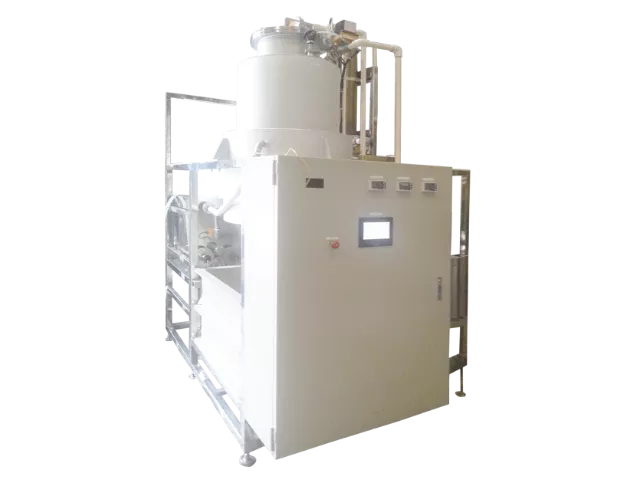
1 /
1
MD Membrane Distillation System
Description:
Food processing、Pharmaceuticals、Chemical manufacturing、Biotechnology、Environmental engineering、Wastewater recycling、Papermaking、Salt production、Printing、Medical biotechnology、High-concentration liquid recovery、High-value liquid recovery、ammonia nitrogen recovery, and other industrial fields
-
Membrane distillation technology utilizes waste heat to increase the temperature of wastewater. The wastewater flows through porous and hydrophobic membranes on one side, while low-temperature water circulates on the other side of the membrane. By controlling the temperature difference between the two sides of the membrane, the vapor pressure difference at the fluid contact surface of the membrane drives water vapor molecules through the membrane pores from the high-temperature side to the low-temperature side, where they condense into liquid. This technology employs porous membranes and can achieve desalination and removal of chemical oxygen demand, ammonia nitrogen, total dissolved solids (TDS), and metal content. Moreover, its operating pressure is low, and when combined with waste heat within a facility, it can significantly reduce operating costs, making it a novel technology suitable for resource integration.
Currently, membrane-based pure water production mainly relies on reverse osmosis, which is a separation technology driven by pressure. In the case of seawater, it has a high salt concentration (approximately 3.5% concentration corresponds to an osmotic pressure of about 25 atmospheres). To carry out reverse osmosis desalination of seawater, the pressure required must be more than double the osmotic pressure (approximately 50-60 atmospheres), making it quite energy-intensive. In recent years, with the increasing development of membrane preparation and engineering application technologies, membrane distillation, which combines the advantages of membrane technology and distillation, has gradually gained attention.
Membrane Distillation vs. Other Traditional Methods: A Comparative Chart

-

-
System introductionMembrane distillation technology utilizes waste heat to increase the temperature of wastewater. The wastewater flows through porous and hydrophobic membranes on one side, while low-temperature water circulates on the other side of the membrane. By controlling the temperature difference between the two sides of the membrane, the vapor pressure difference at the fluid contact surface of the membrane drives water vapor molecules through the membrane pores from the high-temperature side to the low-temperature side, where they condense into liquid. This technology employs porous membranes and can achieve desalination and removal of chemical oxygen demand, ammonia nitrogen, total dissolved solids (TDS), and metal content. Moreover, its operating pressure is low, and when combined with waste heat within a facility, it can significantly reduce operating costs, making it a novel technology suitable for resource integration.
Currently, membrane-based pure water production mainly relies on reverse osmosis, which is a separation technology driven by pressure. In the case of seawater, it has a high salt concentration (approximately 3.5% concentration corresponds to an osmotic pressure of about 25 atmospheres). To carry out reverse osmosis desalination of seawater, the pressure required must be more than double the osmotic pressure (approximately 50-60 atmospheres), making it quite energy-intensive. In recent years, with the increasing development of membrane preparation and engineering application technologies, membrane distillation, which combines the advantages of membrane technology and distillation, has gradually gained attention.
Membrane Distillation vs. Other Traditional Methods: A Comparative Chart

-
Process Flow


